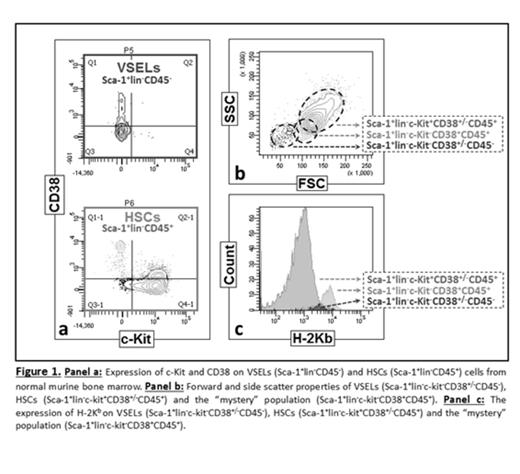Abstract
Background. Almost 20 years ago, a "mystery" population of small stem cells with many of the phenotypic characteristics attributed to resting hematopoietic stem cells was identified in murine bone marrow (BM) (Stem Cells 1998, 16, 38-48). These cells expressed high levels of Sca-1, H-2K, and CD38 and low levels of Thy-1.1; they expressed CD45 antigen but were lineage-negative (lin-) for other hematopoietic markers. These cells incorporated only low levels of Rh123 and were resistant to the cytotoxic effects of 5-fluorouracil. The only phenotypic characteristic that distinguishes these cells from Sca-1+, Lin-, CD45+ Thy-1.1low long-term-reconstituting hematopoietic stem cell population is the lack of c-kit expression. In sum, this "mystery" population of small Sca-1+, lin-, c-kit- but CD45+ stem cells do not respond to hematopoietic growth factors in vitro, form in vivo spleen colonies, or reconstitute lethally irradiated mice. With our discovery of Sca-1+ Lin- CD45- very small embryonic-like stem cells (VSELs) in murine bone marrow (BM) (Leukemia 2006, 20, 857-869), we became interested in this "mystery" population of stem cells. VSELs, like the "mystery" population, are c-kit - and, if freshly isolated from BM, do not show any hematopoietic activity in standard in vitro and in vivo assays. In order to become specified to hematopoiesis, they need to be expanded over an OP-9 stromal support (Exp Hematol 2011;39:225-237).
Hypothesis. Since (1) very small CD45- VSELs can be specified in OP-9 co-cultures into long-term reconstituting CD45+ HSCs, (2) the size of the "mystery" population is intermediate between VSELs and HSCs, and (3) VSELs and HSCs differ in cell surface receptor expression, we hypothesized that the "mystery" population is a missing developmental intermediate between VSELs and HSCs.
Materials and Methods. Multicolor FACS analysis was employed to compare size and expression of surface markers between murine BM HSCs, the unknown population of stem cells, and VSELs. Next, the populations of small Sca-1+ H2-K+ lin- c-kit+ CD38+/- CD45+ cells (HSCs), smaller Sca-1+ H-2K+ lin- c-kit- CD38+ CD45+ cells (the "mystery" population), and very small in size Sca-1+ H-2K+ lin- c-kit- CD38+/- CD45- cells (VSELs) were purified by FACS from BM (Figure 1) and tested for in vitro colony formation. All these cell populations were primed/expanded over OP-9 support and subsequently evaluated for their hematopoietic potential after passaging in consecutive methylocellulose cultures (passages 1-4). RQ-PCR analysis was employed for detection of pluripotency marker expression as well as hematopoietic gene expression.
Results. We found that, in contrast to HSCs, neither freshly sorted stem cells from the "mystery" BM population nor, as expected, VSELs grew hematopoietic colonies in standard methylcellulose cultures. This was also an important step in excluding contamination of our sorted populations with clonogenic cells. We also found that, while VSELs highly expressed Oct-4, this transcription factor was expressed at very low levels in the "mystery" population and was not detectable in HSCs. The most important observation was that the "mystery" population of stem cells became specified in OP-9-supported cultures into clonogenic HSPCs, and this specification occurred faster than the delayed specification of VSELs. VSELs first became enriched for HSPCs after acquiring CD45 antigen expression.
Conclusions. Based on the results presented, we propose that the "mystery" population in murine BM is a population of stem cells intermediate between the most primitive population of BM-residing stem cells (VSELs) and the population of stem cells already specified to lympho-hematopoietic development (HSCs).
No relevant conflicts of interest to declare.
Author notes
Asterisk with author names denotes non-ASH members.


This feature is available to Subscribers Only
Sign In or Create an Account Close Modal